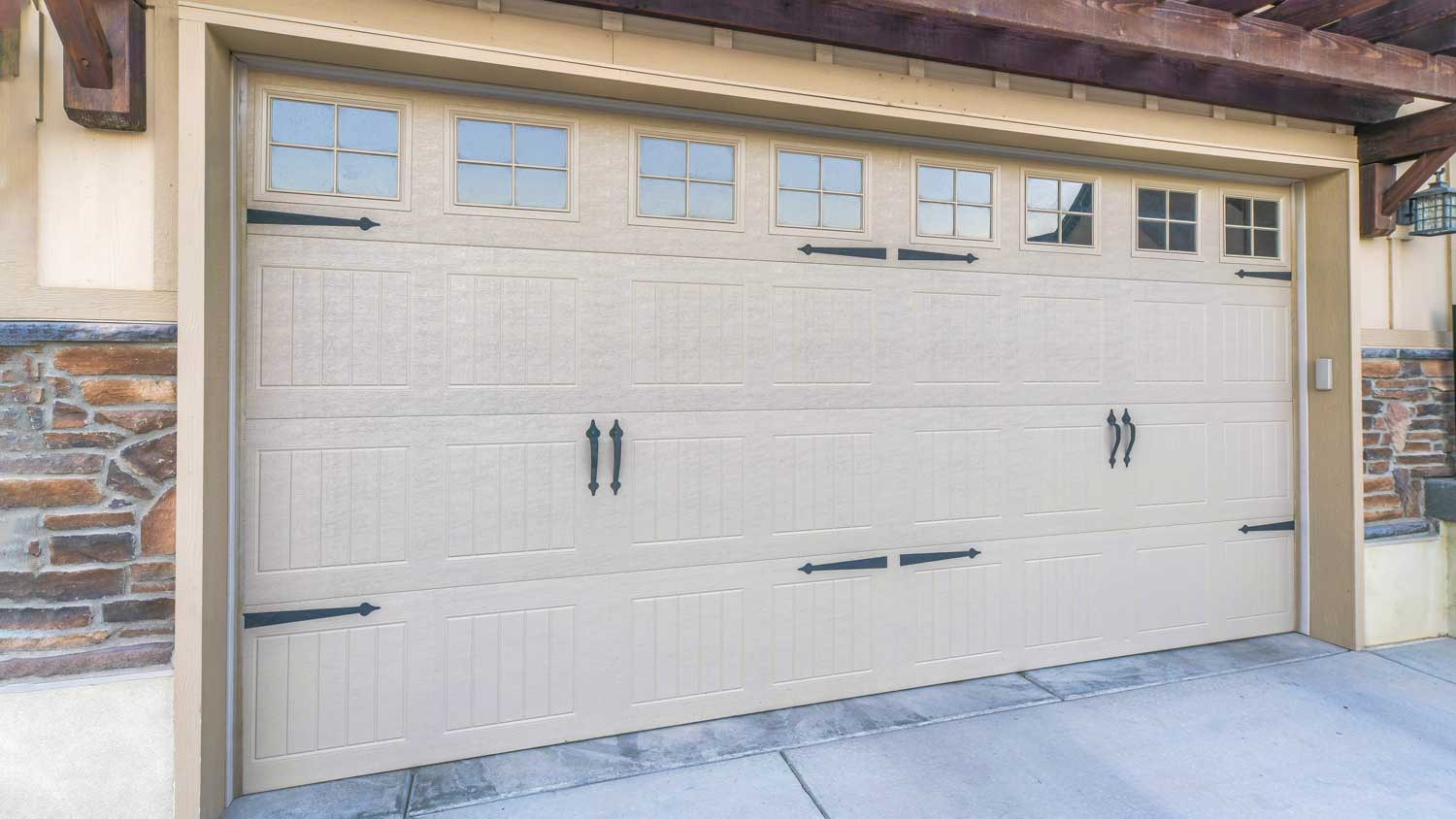How to Lubricate Your Garage Door in Under an Hour
Keep your garage opening and closing smoothly for years


- Ladder
- Damp rag
- Wet / dry vacuum (optional)
- Lithium- or silicone-based garage door lubricant
- Brake cleaner (optional)
Lubricating your garage door is an important task that you should tackle every three to six months to keep it operating smoothly (and without a loud squeaky sound). Luckily, the job is easy enough for the typical homeowner. You just need an aerosol can of garage door lube and an hour to spare on the weekend, and you can knock this job out all by yourself.
Below, we’ll walk you through how to lube a garage door—and which lubricant works best.
Buying Lubricant for Your Garage Door
Before you can begin lubricating your door, make sure you have the right supplies. While you can use a multi-purse lube product like WD-40 in a pinch, it can attract dirt and dust after you apply it.
Instead, visit your local hardware store or browse online for a lithium- or silicone-based garage door lubricant (lithium is preferred). You can find this lube for less than $10, and you’ll get a lot of use out of it.
How to Lubricate a Garage Door
Once you’ve purchased the proper lube for your garage door, here’s what you need to do:
Turn Off Power to the Garage Door
 Photo: H_Ko / Adobe Stock
Photo: H_Ko / Adobe StockSafety first. Never start working on a garage door that is still plugged in. If you can’t easily access the cord, or if the door is hardwired, simply shut off power to the garage via the proper breaker in the circuit box.
Thoroughly Clean and Inspect the Tracks and Components
 Photo: Yuliya Taba / E+ / Getty Images
Photo: Yuliya Taba / E+ / Getty ImagesBefore applying the lube, take the opportunity to clean the tracks and components. You won’t actually apply lubricant to the garage door tracks, but if they get packed with debris, it can degrade performance over time.
Start by taking a damp cloth and running it through the tracks. If there is stubborn debris that won’t come loose, run the hose of your wet / dry vac over it. Brake cleaner can also help break down grime.
You’ll also want to wipe down all the components to which you’ll be applying the lube; this helps the lubricant adhere better. Use your ladder for any higher-up, hard-to-reach components.
Lubricate All Components
 Photo: knowlesgallery / Adobe Stock
Photo: knowlesgallery / Adobe StockYour garage door has several mechanical components that should be lubricated. Make sure you hit them all:
Hinges: Each panel of the garage door is connected via hinges on either side. Spray a small amount of the lube onto the hinge pins; one or two sprays per hinge should do the trick. If you spray too much, wipe up any excess with your cloth.
Rollers: The rollers help with the up and down movement of the hinges. Each one has small ball bearings, which you need to lubricate. Use the hose attachment to lube these; again, a little bit of lube goes a long way. Wipe up any excess grease.
Springs and bearing plates: Grab the ladder and spray lube along the entire length of the springs, and get the bearing plates on either end. You’ll want to move the garage door up and down manually after spraying the springs; doing so will help spread the grease around.
Lock and armbar: Finally, use the ladder to reach the lock and armbar. You only need to spray a little amount in the lock’s keyhole; you’ll also want to spray lube onto the armbar.
You may also want to hit the top of the rail—what the chain runs on, along the ceiling of your garage—with a small amount of lube. Check your owner’s manual, however; the rail might already have a natural protectant on it. If you do lubricate the rail, as with the other components, have a rag handy to wipe up excess grease.
Check Your Work and Repeat if Necessary
 Photo: mirsad sarajlic / iStock / Getty Images Plus / Getty Images
Photo: mirsad sarajlic / iStock / Getty Images Plus / Getty ImagesTurn the power to the garage door back on and try opening and closing it. Does it feel and sound smoother? If you can still hear squeaks, you may need to apply more lube.
If it seems to be working properly, your work is done. Repeat these steps on any additional doors your garage has.
If you notice more serious issues with your garage door components when cleaning and lubricating them, contact a professional garage door company in your area to address the problem.
Frequently Asked Questions
The best lubricant for garage door components such as hinges and springs is a lithium- or silicone-based lube made specifically for garage doors. You can find this online or at a hardware store for less than $10.
While you can technically use WD-40 to lube a garage door, it is not the best option since the oil it leaves behind can attract dirt. Instead, go to the hardware store and locate a lithium- or silicone- based garage grease. You can also search for garage door lubricant online; just make sure you get one that is made with lithium or silicone.
You should spray garage door lubricant on its important mechanical parts, including the hinges, rollers, springs, bearing plates, lock, armbar, and, potentially, rail. Do not lube the tracks, though you should clean these regularly for optimal performance.
You should lube your garage door components every three to six months depending on how frequently you open and close the door. Lubricant helps keep garage door components operating smoothly for longer; you can expect a much longer lifespan out of a garage door when you properly care for it, including frequent lubrication. Regular maintenance is much more affordable than the cost of replacing a garage door prematurely.



















